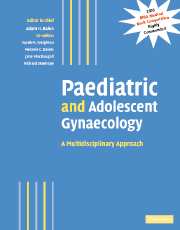Book contents
- Frontmatter
- Contents
- Contributors
- Preface
- Part I Normal development
- 1 Embryology of the female genital tract
- 2 Molecular genetics of gonad development
- 3 Gonadotrophin receptors
- 4 Normal childhood, puberty and adolescence
- 5 Control of the menstrual cycle and fertility
- 6 Nutrition and reproductive function
- 7 Normal bladder control and function
- 8 Development of sexuality: psychological perspectives
- Part II Management of developmental abnormalities of the genital tract
- Part III Management of specific disorders
- Index
- Plate section
- References
2 - Molecular genetics of gonad development
from Part I - Normal development
Published online by Cambridge University Press: 04 May 2010
- Frontmatter
- Contents
- Contributors
- Preface
- Part I Normal development
- 1 Embryology of the female genital tract
- 2 Molecular genetics of gonad development
- 3 Gonadotrophin receptors
- 4 Normal childhood, puberty and adolescence
- 5 Control of the menstrual cycle and fertility
- 6 Nutrition and reproductive function
- 7 Normal bladder control and function
- 8 Development of sexuality: psychological perspectives
- Part II Management of developmental abnormalities of the genital tract
- Part III Management of specific disorders
- Index
- Plate section
- References
Summary
Introduction
Sex determination involves the commitment of the embryo to follow either a male or female developmental pathway. The key step in this process is the development of the undifferentiated embryonic gonads into either testes or ovaries. In humans, sex is determined at the moment of fertilization by the constitution of the sex chromosomes. Two X chromosomes result in ovaries and a female phenotype while an X and Y constitution produces testes and male development.
It has been known for some time that the Y chromosome carries a dominant testis-determining gene, which causes the undifferentiated embryonic gonad to develop as a testis. The masculinizing effect of the testis results from the secretion of the hormones testosterone and anti-Müllerian hormone (AMH; also known as Müllerian inhibitory substance, MIS). AMH causes regression of the embryonic female Müllerian ducts. In the absence of the Y chromosome (and absence of the testis-determining gene), ovaries will develop. Interestingly, female development will still occur in the absence of ovaries or their hormonal products. Consequently, the decisive event in sex determination is whether or not a testis develops. In humans and other mammals, sex determination can be equated with testis determination.
This chapter describes what we know of the genes that control human gonad development and how alterations in these genes can cause sex-reversed phenotypes. The Y-linked testis-determining gene SRY and others in this complex developmental network, such as SOX9, WT1, SF1, DAX1 and DMRT1, are discussed.
- Type
- Chapter
- Information
- Paediatric and Adolescent GynaecologyA Multidisciplinary Approach, pp. 9 - 21Publisher: Cambridge University PressPrint publication year: 2004



